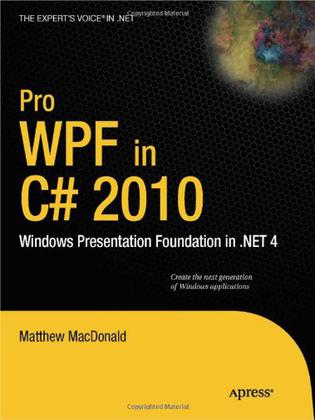作者:
Matthew MacDonald
Microsoft's Windows Presentation Foundation (WPF) provides the foundation for building applications and high-quality user experiences for the Windows operating system. It blends the application user interface, documents, and media content, while exploiting the full power of your computer's operating system. Its functionality extends to the support for tablet PCs and other forms of input device, and it provides a more modern imaging and printing pipeline, accessibility and UI automation infrastructure, data-driven user interfaces and visualization, and integration points for weaving the application experience into the Windows shell. This book shows you how WPF really works. It provides you with the no-nonsense, practical advice that you need in order to build high-quality WPF applications quickly and easily. After giving you a firm foundation, it goes on to explore the more advance aspects of WPF and how they relate to the others elements of the .NET 4.0 platform and associated technologies such as Silverlight. What you'll learn * WPF basics: XAML, layout, control essentials, and data flow * WPF applications: Navigation, commands, localization, and deployment * Advanced controls: Custom controls, menus, toolbars, and trees * WPF documents: Text layout, printing, and document packaging * Graphics and multimedia: Drawing shapes, sound and video, animation, geometric transformations, and imaging Who this book is for This book is designed for developers encountering WPF for the first time in their professional lives. A working knowledge of C# and the basic architecture of .NET is helpful to follow the examples easily, but all concepts will be explained from the ground up. Table of Contents1. Introducing WPF 2. XAML 3. Layout 4. Dependency Properties 5. Routed Events 6. Controls 7. The Application 8. Element Binding 9. Commands 10. Resources 11. Styles and Behaviors 12. Shapes, Brushes, and Transforms 13. Geometries and Drawings 14. Effects and Visuals 15. Animation Basics 16. Advanced Animation 17. Control Templates 18. Custom Elements 19. Data Binding 20. Formatting Bound Data 21. Data Views 22. Lists, Trees, and Grids 23. Windows 24. Pages and Navigation 25. Menus, Toolbars, and Ribbons 26. Sound and Video 27. 3-D Drawing 28. Documents 29. Printing 30. Interacting with Windows Forms 31. Multithreading 32. The Add-in Model 33. ClickOnce Deployment
 Pro WPF in C# 2010txt,chm,pdf,epub,mobi下载
Pro WPF in C# 2010txt,chm,pdf,epub,mobi下载 老52024-06-27 11:44:51
老52024-06-27 11:44:51
